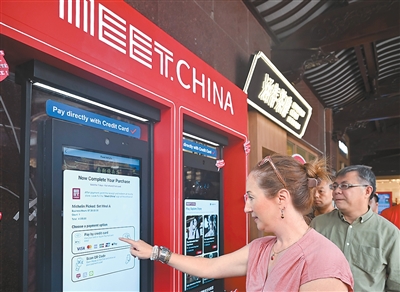




- BRNN
- BRI News
- BRNN News
- Database
Official Documents Polices and Regulations
Inter-government Documents International Cooperation BRI Countries
Business Guide Economic Data BRI Data
Trade
Investment Projects Latest projects
Cases - Content Pool
China's tourism industry delivered impressive results during the eight-day National Day and Mid-Autumn Festival holiday, with domestic tourist numbers, spending, travel distances, and inbound and outbound visitor volumes all reaching record highs.
These results reflect robust consumer activity and a thriving market, underscoring the country's economic vitality and the tourism sector's innovative development.

A foreign guest tries to use the "Meet China" Inbound Tourism Digital Consumption Screen in Yuyuan Garden, Shanghai. The first national site of the "Meet China" Inbound Tourism Digital Consumption Screen was launched here in late September. (Xinhua/Chen Haoming)
A notable shift emerged during this holiday period as travelers increasingly bypassed well-known attractions and traditional tourist cities in favor of distinctive, smaller cities. Jingdezhen in east China's Jiangxi Province exemplified this trend.
The city's "ceramic cultural heritage tour" emerged as a breakout attraction during the holiday, drawing visitors eager for immersive experiences in porcelain-making and other cultural tourism offerings. Data from Meituan Travel showed tourism bookings in Jingdezhen rose 15 percent year on year, with visitors aged 20 to 30 accounting for half of all tourists. Orders at local five-star hotels climbed nearly 30 percent compared with the same period last year.
According to consumption data from Douyin's life services business for the National Day holiday, smaller cities with distinctive local features proved especially popular, seeing a surge in accommodation demand. From Oct. 1 to 7, hotel group-buying orders in Kaifeng, Tangshan and Chengde increased 157 percent, 147 percent and 145 percent year on year, respectively. Weihai, Chizhou, Dali and Huzhou all saw bookings double, while Qinhuangdao, Lingshui and Zhoushan posted growth of 99 percent, 98 percent and 79 percent, respectively.
Dai Bin, president of the China Tourism Academy, noted that tourism is entering a new phase characterized by diversity, personalization and quality. While major destinations, scenic spots and museums remain top choices for travelers, improved transportation infrastructure, social media promotion and grassroots efforts have made county-level tourism a new highlight in mass tourism development.
According to a survey by the Ministry of Culture and Tourism, 45.7 percent of travelers chose self-drive trips during the National Day and Mid-Autumn Festival holiday, with roadside scenery emerging as a new tourism attraction.
The Baiyinnao volcano-themed service area on the G55 Erenhot-Guangzhou Expressway, featuring giant astronaut sculptures and aerospace- and geology-themed decorations, began trial operations during the National Day holiday. It is the country's first immersive service area combining volcanic geology with aerospace education.
An increasing number of service areas, such as Baiyinnao, are transforming from simple rest stops into leisure destinations, with some even becoming new tourism landmarks.
Today's service areas offer a diverse range of amenities to cater to varied shopping and leisure needs, while showcasing distinctive local characteristics. For instance, the Yangcheng Lake service area on the Beijing-Shanghai Expressway in east China's Jiangsu Province features Suzhou-style classical gardens, Suzhou Pingtan performances and demonstrations of intangible cultural heritage.
Immersive experiences have become a common strategy both for traditional attractions looking to reinvent themselves and for emerging destinations creating new tourism products. At a scenic area in Libo county, southwest China's Guizhou Province, visitors can sip coffee on cliffs or enjoy hot pot in underground caves. At the Shenzhen Science and Technology Museum in south China's Guangdong Province, guests can explore space exhibits and chat with humanoid robots.
Driven by innovation, regions across the country are creating engaging, culturally rich tourism experiences.

Tel:86-10-65363107, 86-10-65368220, 86-10-65363106